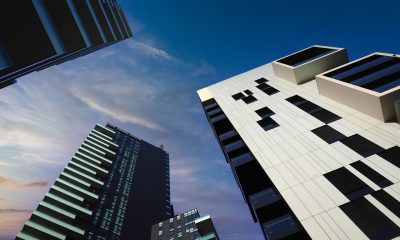Business
How Population is Changing the Real Estate Market
For real estate investors, a good barometer of current and future growth is new residential construction. The top five cities spending the most on new residential construction are Austin, Texas; Nashville, Tennessee; Raleigh, North Carolina; Jacksonville, Florida; and Phoenix, Arizona, respectively. By state, the list goes Idaho, Utah, Colorado, South Carolina, and Florida, respectively.

Any realtor or real estate investor is fond of saying, “Location! Location! Location!” But, upon further examination of what causes real estate prices to rise and fall, it may be more accurate to shout, “Population! Population! Population!” People are constantly on the move, searching for a better life. It is their journey, these moving microeconomies, that ultimately dictate the value of any macroeconomy be it a neighborhood, region, state, or even country.
To understand the makeup of current real estate markets, a quick refresher on how today’s landscape came to be is in order. The United States’ last great expansion was in 1867, when the US purchased Alaska from Russia and acquired 586,412 square miles for a paltry sum of $7.2 million (The Top 10 Nation-Building Real Estate Deals). Hawaii and Alaska were admitted as the last two states in 1959 which brought the American land total to 3.5 million square miles at a time when the population was 179 million.
Geographical expansion brought about many advantages like valuable natural resources and trade routes. Space, privacy, and wide-open land was readily available. In 1790, 90 percent of America’s population lived on farms and ranches. However, this distance became a major detriment as it further separated economies and strained centers of control. Colonial Americans quickly realized the need for proximity and the endless benefits of collaboration. The result was urbanization, the movement of populations from rural areas to urban ones. In 1810, there were only two cities with populations of more than 50,000, but by 1860 there were sixteen. Fast-forward to 1920, and for the first time in American history more people lived in cities than in rural areas (America Moves to The City). Since 1959, America’s land mass has remained relatively unchanged, while the population has climbed to over 330 million. Whether it was when there were few Americans or today when there are multitudes, the people of the United States have always been on the move.
At the dawn of America, one of the main attractions of urban living was the exchange of information, a physical connection of producers and consumers. It could take days to relay sensitive information across a state, and weeks for it to travel coast to coast. History tells of battles being fought amid wars that had already ended and companies negotiating for the future that had already declared bankruptcy, all because of information lag. Cities cured this malady.
Nowadays, 5G and a good Wi-Fi signal have become as important as roads and bridges. Virtual pathways have knocked down borders between here and there. The explosion of remote working and learning during the Covid-19 pandemic spurred the opposite effect of urbanization; it is called ruralization. From 2010–2019, 60 percent of all metro areas experienced more growth in suburbs than in cities (Suburbs vs Cities). Home values soared during the pandemic, while commercial properties plummeted as people chose where to live and where not to work. The locality factor in economics may be motivated more now by lifestyle than employment.
While global population growth is 100 percent organic (we’ve yet to import any aliens), national population growth can be part organic and part extraneous through immigration. Population dynamics within the United States are now attributed more to relocation than intrinsic growth. According to the 2021 US Census Bureau, of the 10 fastest-growing cities in the United States, 5 of them are in Texas. The majority of this growth is due to migration. Some of the major reasons credited for the influx are low crime rates, high-income opportunities, and top-ranked public education (Fasting-Growing Cities are Still in the West and South).
For real estate investors, a good barometer of current and future growth is new residential construction. The top five cities spending the most on new residential construction are Austin, Texas; Nashville, Tennessee; Raleigh, North Carolina; Jacksonville, Florida; and Phoenix, Arizona, respectively (US Cities Spending the Most on Residential Construction). By state, the list goes Idaho, Utah, Colorado, South Carolina, and Florida, respectively. It should come as no surprise that corporate relocations neatly coincide with migration trends, with Austin, Nashville, and Denver all being hotspots for corporate expansion.
One of Yogi Berra’s classic lines goes, “Nobody goes there anymore. It’s too crowded.” Any restaurant, hotel, or other venue would love to face such a predicament. When an investor, developer, or government undertakes any project seeking a return, which is every project, they are focused on population. Yes, they will obviously consider benefits of a certain locale (near the water, warm climate, efficient public transportation, business-friendly environment, etc.), but these are all just lures for more people. So as the stock market is considered a leading economic indicator, meaning the market’s value is already reflecting anticipated events good and bad in the economy, so might population migration be a projection of an area’s future worth. The “If you build it, they will come” strategy is one of speculation, high risk/high reward, versus the conservative approach of analyzing migration trends before jumping in.
The most direct correlation in property values is the connection to population growth. Generally speaking, higher population growth equals higher home values, a classic illustration of supply and demand. A real estate investor who foresaw California to Texas or Northeast to Florida pipelines and purchased in any of the cities referenced earlier a few years before they made the list has clearly been rewarded with a profit. The latest migration trends would suggest that a good financial indicator would be investing in young, liberal cities inside conservative states, such as Austin, Texas, or Nashville, Tennessee.
__
(Featured image by nattanan23 via Pixabay)
DISCLAIMER: This article was written by a third party contributor and does not reflect the opinion of Born2Invest, its management, staff or its associates. Please review our disclaimer for more information.
This article may include forward-looking statements. These forward-looking statements generally are identified by the words “believe,” “project,” “estimate,” “become,” “plan,” “will,” and similar expressions. These forward-looking statements involve known and unknown risks as well as uncertainties, including those discussed in the following cautionary statements and elsewhere in this article and on this site. Although the Company may believe that its expectations are based on reasonable assumptions, the actual results that the Company may achieve may differ materially from any forward-looking statements, which reflect the opinions of the management of the Company only as of the date hereof. Additionally, please make sure to read these important disclosures.

-

 Impact Investing1 week ago
Impact Investing1 week agoVernazza Autogru Secures €5M Green Loan to Drive Sustainable Innovation in Heavy Transport
-

 Markets4 days ago
Markets4 days agoRice Market Slips Amid USDA Revisions and Quality Concerns
-

 Business2 weeks ago
Business2 weeks agoLegal Process for Dividing Real Estate Inheritance
-

 Fintech12 hours ago
Fintech12 hours agoJPMorgan’s Data Fees Shake Fintech: PayPal Takes a Hit
























